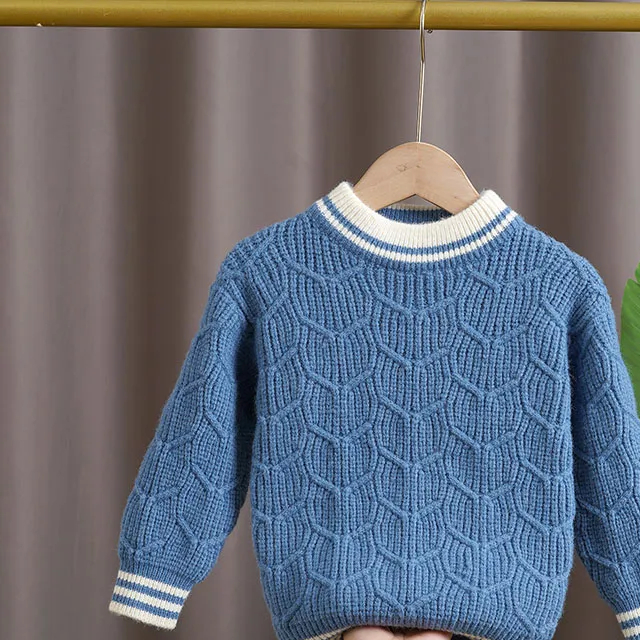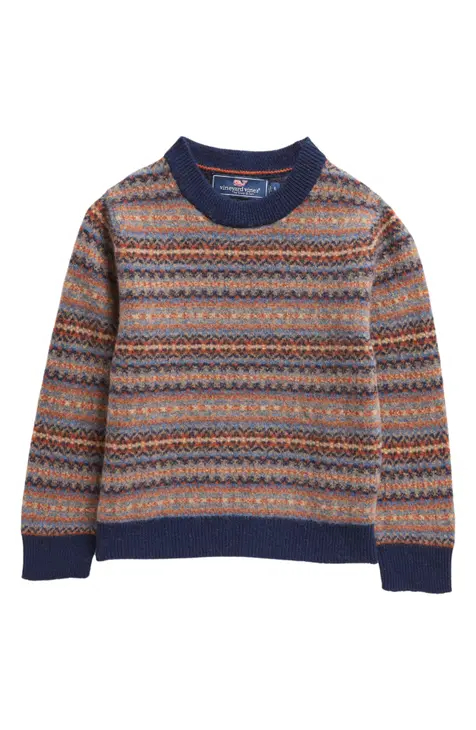Sweaters for boys, selecting the perfect sweater for a boy is more than just about warmth; it’s about comfort, style, practicality, and durability. This comprehensive guide delves into the multifaceted aspects to consider when choosing boys’ sweaters, taking into account their unique needs, preferences, and the diverse array of options available in the market.

Understanding Materials
Natural Fibers
Wool, cashmere, and cotton are popular choices due to their natural insulation properties, breathability, and hypoallergenic qualities. Wool offers excellent warmth without bulk, while cashmere is renowned for its softness and luxury feel. Cotton is lightweight, easy to care for, and ideal for milder weather or indoor wear.
Synthetic Fibers
Polyester, acrylic, and blends with natural fibers offer affordability, resistance to wear and tear, and ease of maintenance. These materials can mimic the look and feel of natural fibers but often provide better color retention and wrinkle-resistance.
Blends
Many boys’ sweaters are crafted from fabric blends that combine the best attributes of different fibers. For instance, wool-cotton blends balance warmth with breathability, and wool-acrylic blends offer warmth at an affordable price point.
Fit and Comfort
Size and Fit
When selecting a sweater for a boy, ensure a comfortable fit that allows for movement and layering. Avoid overly tight garments that may restrict playtime activities or cause discomfort. Opt for sweaters with adjustable features like drawstrings, elasticated cuffs, or waistbands.
Necklines and Sleeves
Consider the neckline based on the child’s preference and layering needs – crew necks are versatile, V-necks add sophistication, and high necks provide extra warmth. Sleeve length should accommodate growth spurts and seasonal changes.

Texture and Design
From chunky knits for added warmth to lightweight weaves suitable for transitional seasons, textures greatly impact the functionality and aesthetics of a sweater. Designs range from classic stripes and argyle patterns to trendy graphic prints or character motifs that cater to boys’ interests and personalities.
Durability and Quality
Investigate the quality of seams, hems, and closures to ensure durability. Reinforced areas around the elbows and underarms are a sign of robust construction. High-quality zippers and buttons will withstand daily use and laundering. Look for sweaters with minimal pilling and colorfastness to maintain their appearance over time.
Versatility and Style
Choose sweaters that can be dressed up or down, coordinating well with both casual jeans and dressier pants. Neutral colors like navy, grey, and black offer timeless versatility, while brighter hues and bold patterns can reflect the boy’s individuality.
Sustainability and Ethics
With growing concerns over environmental impact and ethical manufacturing practices, consider brands that prioritize sustainable materials, fair trade production, and reduced carbon footprint. Organic cotton, recycled polyester, and responsibly sourced wool are eco-friendly options.

How to clean boys’ sweaters
Understanding Your Sweater’s Fabric
Natural Fibers
Sweaters made from wool, cashmere, or cotton require specific care. Wool should generally be hand washed with a gentle detergent formulated for delicates or dry cleaned to avoid shrinkage and felting. Cashmere, similarly, benefits from hand washing, mild soap, and air-drying flat to prevent stretching. Cotton can typically be machine-washed on a gentle cycle using cold water, but always refer to the manufacturer’s instructions.
Synthetic and Blended Fibers
Acrylic, polyester, and blended sweaters are often more resilient and can withstand machine washing on a cool setting. However, they may still pill and benefit from being placed in a mesh laundry bag to reduce friction. Always check labels for any specific washing guidelines.
Pre-Cleaning Steps
Before washing, remove any loose dirt or debris by gently brushing the sweater. Turn the sweater inside out to minimize rubbing against zippers or buttons during the wash cycle, which can cause snags. For heavily soiled areas, spot-treat with a stain remover before proceeding with the wash process.
Washing Techniques
Hand Washing
Fill a sink or basin with lukewarm water mixed with a small amount of mild detergent. Submerge the sweater, gently agitate the water to distribute the soap, then let it soak for a few minutes. Do not wring or twist; instead, press out excess water and lay it flat on a clean towel to absorb moisture. Reshape the sweater while damp and allow it to air dry completely.
Machine Washing
For sweaters that can tolerate machine washing, use the gentlest cycle possible and select cold water. Use a specialized detergent for delicate fabrics, and consider adding a fabric softener sheet to reduce static electricity. Once the cycle is complete, immediately remove the sweater to avoid wrinkles and color bleeding from other clothes.
Dealing with Pills
Pilling is a common issue with sweaters due to fiber breakage and movement. To remove pills, use a fabric comb or a special sweater stone designed to shave off the pills without damaging the fibers. Regularly de-pilling will help maintain a smooth surface and extend the life of the garment.

Drying and Storage
Never hang a wet sweater as it can stretch and lose its shape. Instead, lay it flat on a drying rack or clean towel, reshaping it to its original dimensions. Store folded in a drawer or on a shelf rather than hanging, and keep away from direct sunlight and heat sources to prevent fading and damage. Consider using moth repellents if storing for extended periods.
The longevity and appearance of boys’ sweaters largely depend on proper cleaning and storage practices. By understanding the nature of the fabric, using gentle methods, and taking preventive measures against wear and tear, you can ensure that these garments remain a staple in your child’s wardrobe. Educating children about these practices early on can also instill good habits that will serve them well in the future, teaching them the value of caring for their belongings and reducing unnecessary waste.
Conclusion
Purchasing a boys’ sweater is a thoughtful process that requires balancing fashion with function, comfort with durability, and personal style with practical considerations. By carefully weighing the material, fit, design, durability, versatility, and sustainability, you can select a sweater that not only keeps your young man warm and stylish but also aligns with your values as a conscientious consumer.
Remember, investing in high-quality pieces that stand the test of time can save money in the long run and teach children the value of well-made clothing. With this guide in hand, you’re equipped to navigate the world of boys’ sweaters and make selections that will bring joy and warmth to your little one throughout the seasons.










